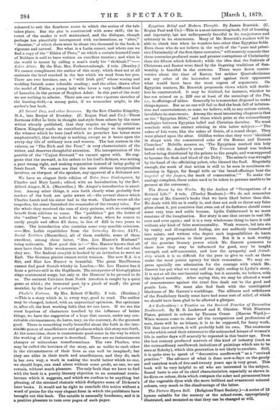Egyptian Belief and Modern Thought. By James Bonwick. (C. Kegan
Paul and Co.)—This is a most interesting book, full of learning and ingenuity, bat not unfrequently fanciful in its conjectures and arbitrary in its statements. Many of Mr. Bonwick's readers will be able to check him when he wanders into other than Egyptian fields Even those who do not believe in the myth of the "pure and primi- tive Christianity of the first three centuries," will scarcely concede that these centuries produced more and greater corruptions of Christianity than the fifteen which followed ; while the idea that the festivals of Christmas and Easter were fixed by the lingering traditions of Sun- worship is fanciful in the extreme. There were fierce contro- versies about the time of Easter, but neither Quartodecimans nor any other of the heterodox used against their opponents what would have been the most cogent of arguments. On Egyptian matters, Mr. Bonwick propounds views which will doubt- less be controverted. It may be doubted, for instance, whether he has not missed on p. 229 one at least of the meanings of the Pie, i.e., in offerings of tithes. Generally he is somewhat disposed to make things square. But as no one will fail to find the book full of informa- tion and entertainment, so none, we believe, will, to any serious extent, invalidate its statements. Among the most interesting chapters is that on the "Egyptian Bible," and those which point at the extraordinary analogies between Egyptian belief and Christian doctrine. We must conclude with one extract relating to this latter subject :—" The cakes of Isis were, like the cakes of Osiris, of a round shape. They were placed upon the altar. Glidden writes that they were identical in shape with the consecrated cake of the Roman and Eastern Churches.' Melville assures us, The Egyptians marked this holy bread with St. Andrew's cross.' The Presence bread was broken before being distributed by the priests to the people, and was supposed to become the flesh and blood of the Deity. The miracle was wrought by the hand of the officiating priest, who blessed the food. Singularly enough, the mark of that action is still to be seen in specimens re- maining in Egypt, for Rouge tells us the bread-offerings bear the imprint of the fingers, the mark of consecration.'" To make the analogy complete, these cakes used to be taken to persons unable to be present at the ceremony.


































 Previous page
Previous page